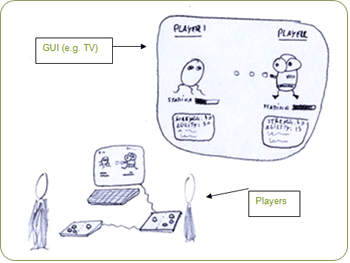Pin & Fight
This idea is based upon the card games that can be found on the market, like the magic card game, or the more famous pokemons, but extended using the pin&play capabilities. The idea behind this is that people could have a set of “cards” consisting of several components no different in shapes or colours, but maybe with a colour led. Each of these components would have an ID and, related to this ID, a set of characteristics such as strength, stamina and so forth. These several “cards” would have a graphical representation on the screen, such as a creature, again quite conceptually similar to the pokemon creatures.
Then, two users could use their set of “cards” in the framework of a game, the computer taking the “dice rolling” and other things such as the combat issues in charge.
Thus, the game could be played in the same room in front of the same computer, or in remote locations using an internet connection.
 PACT Analysis
PACT Analysis
People: This game would suit the regular audience of such games as pokemon, e.g. mostly male, age 7 and up.
Activities: The activities involved in the use of Pin&fight would be the collection of the several pins representing the “monsters”, and their effective use within the system. The interaction with the opponent, real or virtual, has as well to be taken in consideration.
Contexts: This game could be played alone versus the computer, in front of another human component having his own board and set of creatures, but the possibility of playing online with remote adversaries could be considered.
Technology: This system will rely on the use of 1 piece of fabric per player, divided in two zones, one for the user to place his “troops”, and another that can be described as the “combat zone”. A human opponent can plug his personal piece of fabric to the other player’s piece, which itself would be linked to the computer.